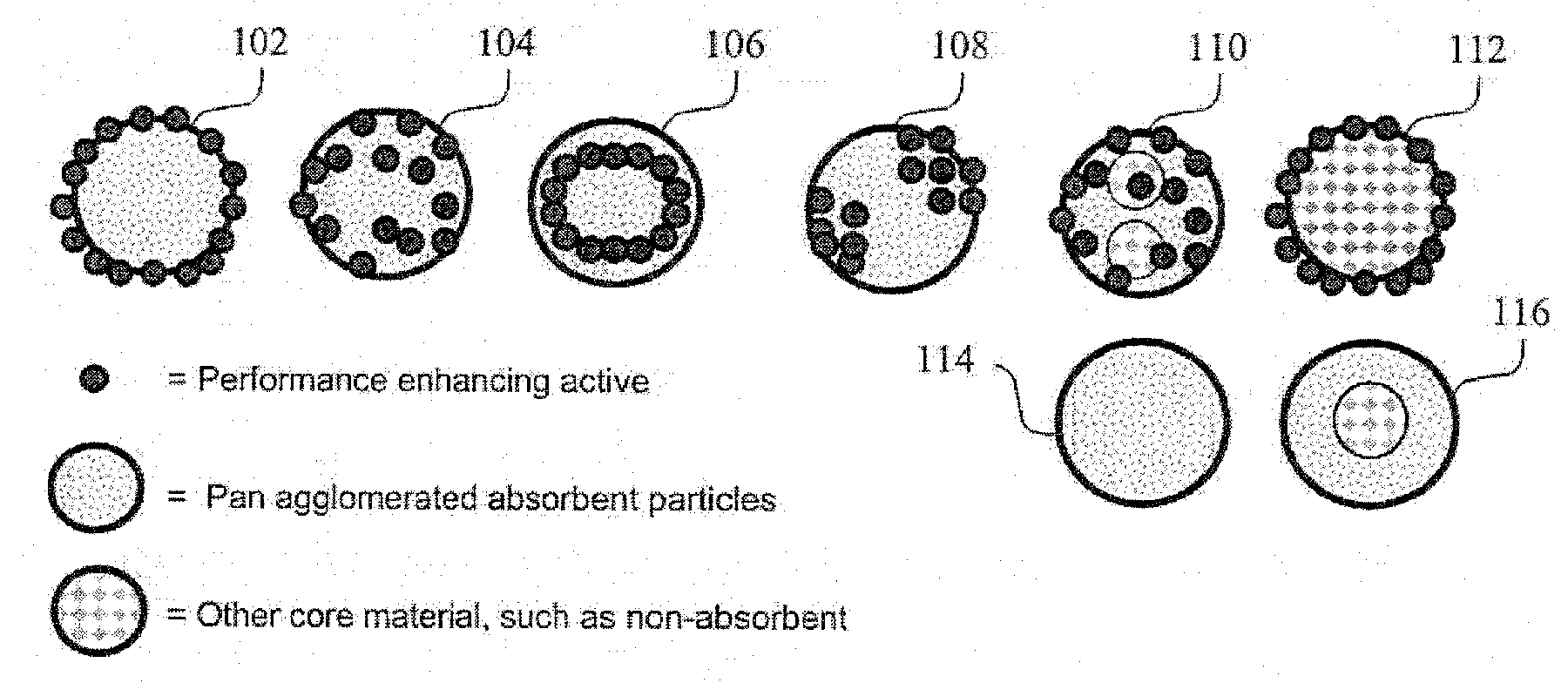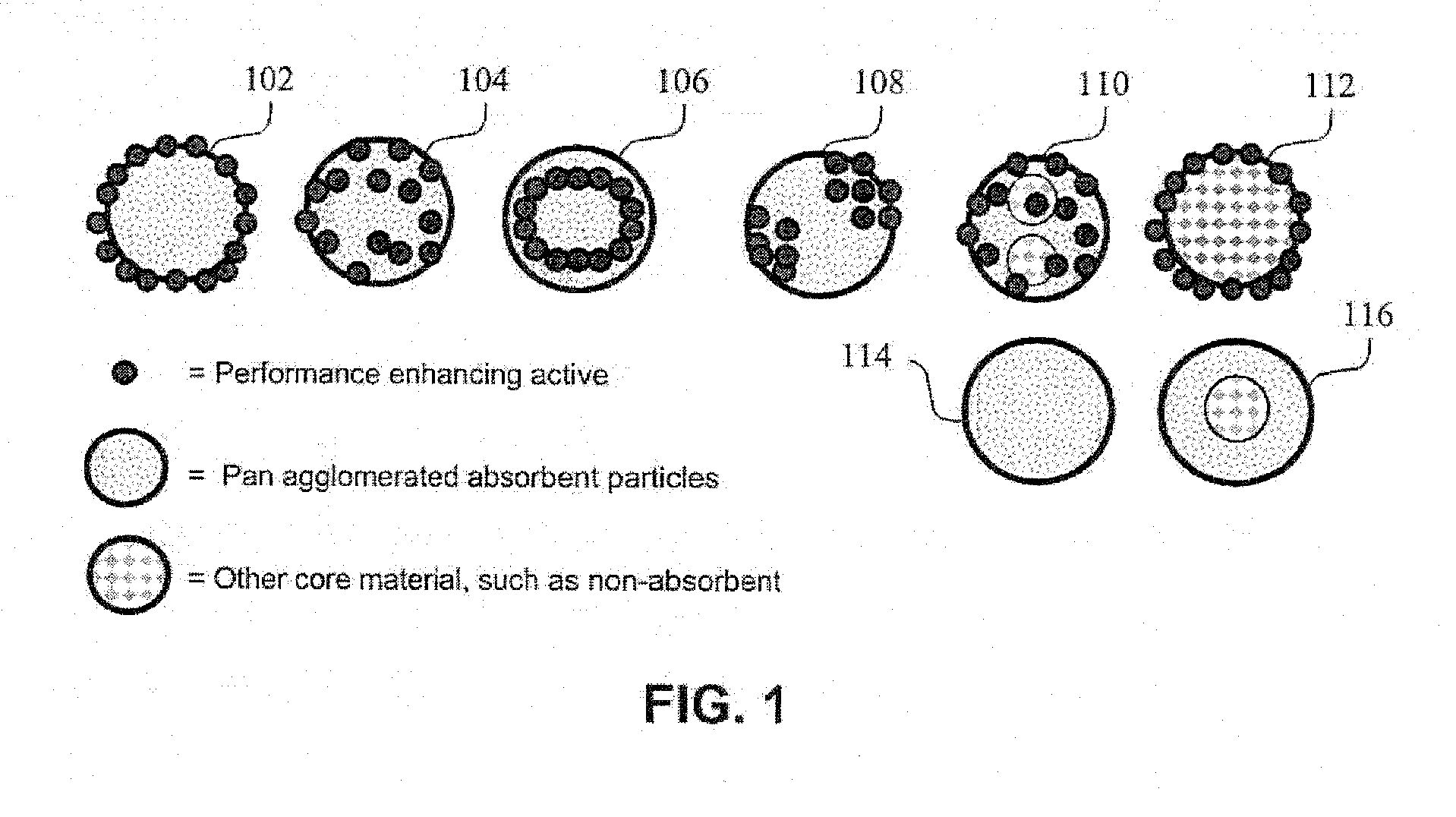Shaped Absorbent Particles
a technology of absorbent particles and absorbent particles, applied in the field of absorbent particles, can solve the problems of form malodor, compound breakage problem, wet litter remaining in the container,
- Summary
- Abstract
- Description
- Claims
- Application Information
AI Technical Summary
Benefits of technology
Problems solved by technology
Method used
Image
Examples
experiment 1
[0121]Cellulose fibers (˜2-3 mm) were added to sodium bentonite clay (about 100-500 mesh) in a pilot plant scale pin mixer equipped with a rotary drier to form composite particles. The particles were then sieve-screened to approximately 12×40 mesh and 6×40 mesh in size. The cellulose fibers were added at 0%, 4%, and 6% levels. Each sample depicted in the tables below represents six clumps. Three of the six clumps were formed by dosing the litter composition with 10 ml of cat urine and waiting 2 hours. The remaining three of the six clumps were formed by dosing the litter compositions with 10 ml of cat urine, waiting 1 hour, then redosing with an additional 10 ml of cat urine and waiting an additional 1 hour. All six clumps were then shaken lightly for 5 seconds. The clumps were pancake-shaped and sticky to the scoop and to the touch.
[0122]Table 2 summarizes the average size, shape and strength of the clumps.
TABLE 2Avg.Avg.Avg.ClumpLongestShortestAvg.StrengthLengthLengthHeightAspect(...
experiment 2
[0123]Cellulose fibers were added to sodium bentonite clay in a pilot plant scale pin mixer equipped with a rotary drier to form composite particles. The cellulose fibers were added at 0%, 4%, and 6% levels. The composite particles were then blended with non-agglomerated bentonite clay and sieve-screened to 12×40 mesh to form a litter composition comprised of a composite blend (i.e., about 35% composite particles: about 65% bentonite clay). Each sample represents the average of three clumps formed by dosing the litter compositions with 10 ml of cat urine and waiting 2 hours (single dose) or the average of three clumps formed by dosing the litter compositions with 10 ml of cat urine, waiting 1 hour, redosing the clumps with an additional 10 ml of cat urine and waiting an additional 1 hour. Longest length, shortest length and height measurements were taken without disturbing the clumps in the box.
[0124]In addition to the clump size, the clump strength was also measured, i.e., the abil...
experiment 3
[0126]Cellulose fibers were added to sodium bentonite clay (about 100-500 mesh) and powder activated carbon (about 25-150 μm) in a pilot plant scale drum mixer equipped with a rotary drier to form composite particles. The composite particles were sieve-screened to about 4×60 mesh. The cellulose fibers were added at 0%, 5%, and 15% levels. Each sample represents three clumps formed by dosing the litter compositions with 10 ml of cat urine and waiting 2 hours (single dose) or three clumps formed by dosing the litter compositions with 10 ml of cat urine, waiting 1 hour, redosing the clumps with an additional 10 ml of cat urine and waiting an additional 1 hour. In addition to the clump size, the clump strength was also measured using the method outlined in Experiment 2 above. Absorbent capacity was calculated by determining the weight of litter needed to absorb 10 ml or cat urine. Absorbency is reported as the grams of urine absorbed per 1 gram of litter composition.
[0127]Table 4 summar...
PUM
| Property | Measurement | Unit |
|---|---|---|
| mean particle diameter | aaaaa | aaaaa |
| mean particle diameter | aaaaa | aaaaa |
| mean particle diameter | aaaaa | aaaaa |
Abstract
Description
Claims
Application Information
 Login to View More
Login to View More - R&D
- Intellectual Property
- Life Sciences
- Materials
- Tech Scout
- Unparalleled Data Quality
- Higher Quality Content
- 60% Fewer Hallucinations
Browse by: Latest US Patents, China's latest patents, Technical Efficacy Thesaurus, Application Domain, Technology Topic, Popular Technical Reports.
© 2025 PatSnap. All rights reserved.Legal|Privacy policy|Modern Slavery Act Transparency Statement|Sitemap|About US| Contact US: help@patsnap.com



